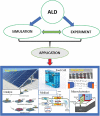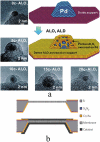New development of atomic layer deposition: processes, methods and applications
- PMID: 31164953
- PMCID: PMC6534251
- DOI: 10.1080/14686996.2019.1599694
New development of atomic layer deposition: processes, methods and applications
Abstract
Atomic layer deposition (ALD) is an ultra-thin film deposition technique that has found many applications owing to its distinct abilities. They include uniform deposition of conformal films with controllable thickness, even on complex three-dimensional surfaces, and can improve the efficiency of electronic devices. This technology has attracted significant interest both for fundamental understanding how the new functional materials can be synthesized by ALD and for numerous practical applications, particularly in advanced nanopatterning for microelectronics, energy storage systems, desalinations, catalysis and medical fields. This review introduces the progress made in ALD, both for computational and experimental methodologies, and provides an outlook of this emerging technology in comparison with other film deposition methods. It discusses experimental approaches and factors that affect the deposition and presents simulation methods, such as molecular dynamics and computational fluid dynamics, which help determine and predict effective ways to optimize ALD processes, hence enabling the reduction in cost, energy waste and adverse environmental impacts. Specific examples are chosen to illustrate the progress in ALD processes and applications that showed a considerable impact on other technologies.
Keywords: 10 Engineering and Structural materials; 102 Porous / Nanoporous / Nanostructured materials; 306 Thin film / Coatings; 400 Modeling / Simulations; Atomic layer deposition; Computational fluid dynamics; Molecular dynamics; Thin film.
Figures


















References
-
- Puurunen RL.A short history of atomic layer deposition: tuomo Suntola‘s atomic layer epitaxy. Chem Vap Deposition. 2014;20:332–344.
-
- Suntola T.Atomic layer epitaxy. Thin Solid Films. 1992;216:84–89.
-
- Li PH, Chu PK. 1 - Thin film deposition technologies and processing of biomaterials In: Griesser HJ, editor. Thin Film coatings for biomaterials and biomedical applications. Duxford (UK): Woodhead Publishing; 2016. p. 3–28.
-
- Pan D, Ma L, Xie Y, et al. On the physical and chemical details of alumina atomic layer deposition: A combined experimental and numerical approach. J Vac Sci Technol A. 2015;33:021511.
-
- Kim H, Lee H-B-R, Maeng W-J. Applications of atomic layer deposition to nanofabrication and emerging nanodevices. Thin Solid Films. 2009February2;517:2563–2580.
Publication types
LinkOut - more resources
Full Text Sources
Other Literature Sources
